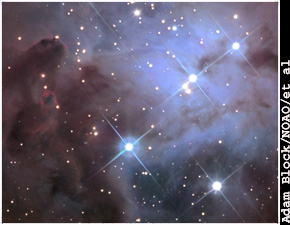|
Mercury, named for the messenger of the gods, is the closesest planet
in our solar system to the Sun. Its cratered surface gives us a look at the turbulance of our early solar system. Mercury
is just a mere 36 million miles from the Sun and its lack of an atmosphere allows for a large variety of temperatures, from
750 degrees Fahrenheit during the day to -330 degrees Fahrenheit at night.
When observing Mercury you may only see a small crescent
in a small telescope and even then it may be a dancing, colorful image due to the fact that it is so close to the Sun and
may be distorted by our own atmosphere which is thicker at the horizon.
|

